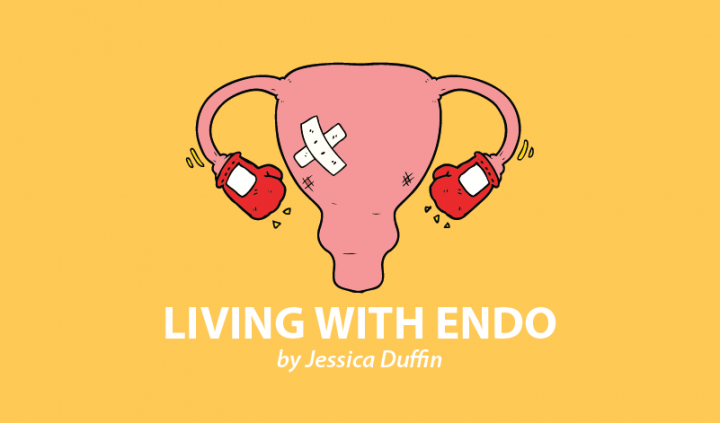My bladder has won.
For a couple of years, endometriosis and interstitial cystitis (IC) have been competing for my attention. Thankfully, I’ve been able to use various nutritional and lifestyle adjustments to quiet the endo symptoms in my body, but not so much with IC. Between the two, IC is definitely the issue causing me the most problems these days.
As I mentioned in a previous column, navigating IC is new territory for me. Practicing new eating habits and therapies and conducting new research wasn’t something I wanted to do alone, especially because it was becoming harder to identify the trigger of my bladder pain.
Bladder pain is pretty complex. There are lists upon lists about what may be contributing to bladder pain, whereas endometriosis is pretty black and white on a basic level: Reduce inflammatory foods and increase anti-inflammatory foods. It can get more complicated, of course, but for many people, reducing foods like sugar, dairy, and gluten can have significant positive results.
But when it came to my IC, I was struggling to work it out alone. Recently, I’ve been lucky to have the support of my tutor, Dr. Jessica Drummond, who’s a functional nutritionist among many other things. Together, we suspected that some of my bladder pain triggers are histamine and oxalates.
She discusses in our podcast episode that generally, we should all have the ability to break down histamines and oxalates, but with people like me, our bodies aren’t in the position to do so. Clinically, Jessica has seen that oxalate sensitivity can contribute to bladder pain, and histamine sensitivity or high levels of histamines can increase pain in general.
I recently had some functional medicine lab tests done, including the GI-MAP and the organic acids test. As graduates of the Integrative Women’s Health Institute, we commonly use these two tests in our work with endometriosis patients who don’t respond to the go-to modifications, such as reducing inflammatory foods, or who have very persistent stomach issues or chronic fatigue. These lab tests showed us that I have low stomach acid, low digestive enzymes, gut dysbiosis, and nutrient malabsorption, resulting in some deficiencies.
Low stomach acid and low digestive enzymes can occur as a result of chronic pain, stress, and fatigue. Low digestive enzymes can also be a result of small intestinal bacterial overgrowth (SIBO), which is indicated as a possibility in my lab results, as I have gut dysbiosis.
Gut dysbiosis means that there’s an imbalance of bacteria in the gut. That doesn’t always mean that SIBO is present, but it can be an indication of it. Low stomach acid can also be a contributing causal factor for SIBO, as stomach acid should be killing off at least some of the bacteria we consume as it enters the stomach.
This results in a digestive system that is struggling to break down food, to absorb nutrients, and in my case, to break down histamines and oxalates. The immune system then reacts to this by creating upregulated inflammation, resulting in higher pain levels.
So what does that mean for me? Well, it certainly doesn’t mean I’ll be like this forever. Our job is to calm my body down, heal my gut, and work out exactly what I’m reacting to.
My elimination diet for bladder pain is finally beginning. It consists of an anti-inflammatory diet for endometriosis, eliminating the usual foods I generally don’t eat anyway, such as gluten, dairy, soy, alcohol, sugar, and caffeine. It also entails eliminating foods that are high in histamines (or foods that can trigger the release of histamine) and oxalates, as well as foods that can trigger autoimmune symptoms, such as grains.
It’s clearly a restrictive diet, which is why this is an elimination diet only and not a long-term diet plan. I’ll do this for four weeks and then reintroduce foods, one by one, to gauge my body’s reaction. If I’m fine, I can add them back in; if I react, I keep them out for another six months before testing again.
A host of supplements will accompany the diet to reestablish my digestive system, including betaine HCl for stomach acid and digestive enzymes, multivitamins, and an antioxidant complex.
I began yesterday and already have tripped by accidentally adding both histamines and oxalates to my diet without realizing it – and I noticed the effects!
It will be a tough month, but it’s a month of restriction in return for a life of little to no bladder pain. I’ll take it.
***
Note: Endometriosis News is strictly a news and information website about the disease. It does not provide medical advice, diagnosis, or treatment. This content is not intended to be a substitute for professional medical advice, diagnosis, or treatment. Always seek the advice of your physician or other qualified health provider with any questions you may have regarding a medical condition. Never disregard professional medical advice or delay in seeking it because of something you have read on this website. The opinions expressed in this column are not those of Endometriosis News or its parent company, BioNews Services, and are intended to spark discussion about issues pertaining to endometriosis.

